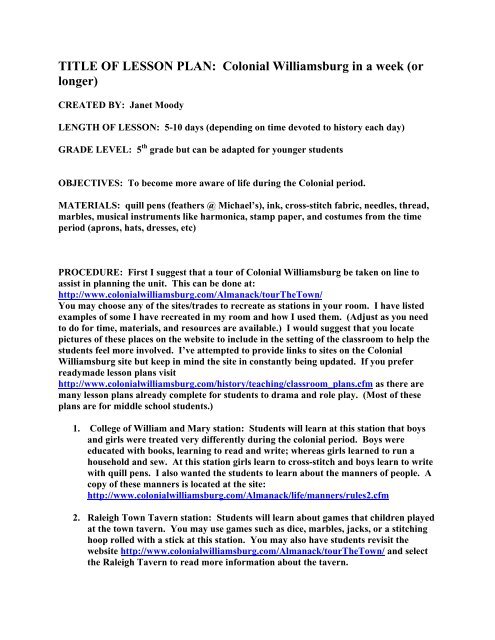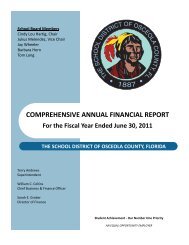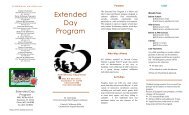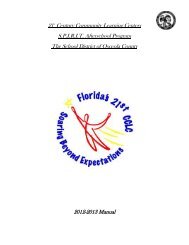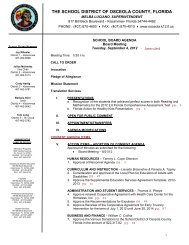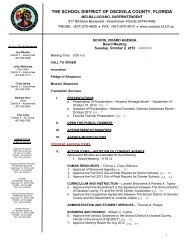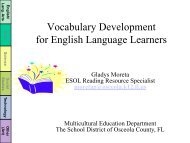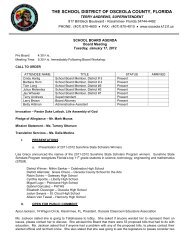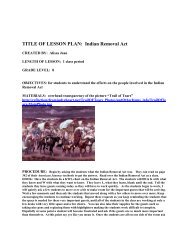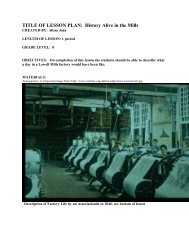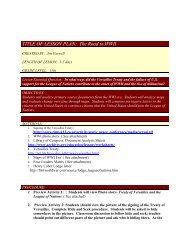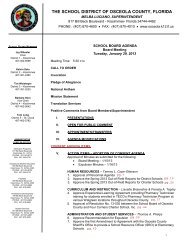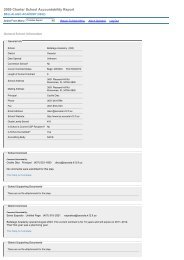TITLE OF LESSON PLAN: Colonial Williamsburg in a week (or longer)
TITLE OF LESSON PLAN: Colonial Williamsburg in a week (or longer)
TITLE OF LESSON PLAN: Colonial Williamsburg in a week (or longer)
You also want an ePaper? Increase the reach of your titles
YUMPU automatically turns print PDFs into web optimized ePapers that Google loves.
<strong>TITLE</strong> <strong>OF</strong> <strong>LESSON</strong> <strong>PLAN</strong>: <strong>Colonial</strong> <strong>Williamsburg</strong> <strong>in</strong> a <strong>week</strong> (<strong>or</strong><br />
<strong>longer</strong>)<br />
CREATED BY: Janet Moody<br />
LENGTH <strong>OF</strong> <strong>LESSON</strong>: 5-10 days (depend<strong>in</strong>g on time devoted to hist<strong>or</strong>y each day)<br />
GRADE LEVEL: 5 th grade but can be adapted f<strong>or</strong> younger students<br />
OBJECTIVES: To become m<strong>or</strong>e aware of life dur<strong>in</strong>g the <strong>Colonial</strong> period.<br />
MATERIALS: quill pens (feathers @ Michael’s), <strong>in</strong>k, cross-stitch fabric, needles, thread,<br />
marbles, musical <strong>in</strong>struments like harmonica, stamp paper, and costumes from the time<br />
period (aprons, hats, dresses, etc)<br />
PROCEDURE: First I suggest that a tour of <strong>Colonial</strong> <strong>Williamsburg</strong> be taken on l<strong>in</strong>e to<br />
assist <strong>in</strong> plann<strong>in</strong>g the unit. This can be done at:<br />
http://www.colonialwilliamsburg.com/Almanack/tourTheTown/<br />
You may choose any of the sites/trades to recreate as stations <strong>in</strong> your room. I have listed<br />
examples of some I have recreated <strong>in</strong> my room and how I used them. (Adjust as you need<br />
to do f<strong>or</strong> time, materials, and resources are available.) I would suggest that you locate<br />
pictures of these places on the website to <strong>in</strong>clude <strong>in</strong> the sett<strong>in</strong>g of the classroom to help the<br />
students feel m<strong>or</strong>e <strong>in</strong>volved. I’ve attempted to provide l<strong>in</strong>ks to sites on the <strong>Colonial</strong><br />
<strong>Williamsburg</strong> site but keep <strong>in</strong> m<strong>in</strong>d the site <strong>in</strong> constantly be<strong>in</strong>g updated. If you prefer<br />
readymade lesson plans visit<br />
http://www.colonialwilliamsburg.com/hist<strong>or</strong>y/teach<strong>in</strong>g/classroom_plans.cfm as there are<br />
many lesson plans already complete f<strong>or</strong> students to drama and role play. (Most of these<br />
plans are f<strong>or</strong> middle school students.)<br />
1. College of William and Mary station: Students will learn at this station that boys<br />
and girls were treated very differently dur<strong>in</strong>g the colonial period. Boys were<br />
educated with books, learn<strong>in</strong>g to read and write; whereas girls learned to run a<br />
household and sew. At this station girls learn to cross-stitch and boys learn to write<br />
with quill pens. I also wanted the students to learn about the manners of people. A<br />
copy of these manners is located at the site:<br />
http://www.colonialwilliamsburg.com/Almanack/life/manners/rules2.cfm<br />
2. Raleigh Town Tavern station: Students will learn about games that children played<br />
at the town tavern. You may use games such as dice, marbles, jacks, <strong>or</strong> a stitch<strong>in</strong>g<br />
hoop rolled with a stick at this station. You may also have students revisit the<br />
website http://www.colonialwilliamsburg.com/Almanack/tourTheTown/ and select<br />
the Raleigh Tavern to read m<strong>or</strong>e <strong>in</strong>f<strong>or</strong>mation about the tavern.
3. Hope Plantation station: Students will learn about the lives of African American<br />
families at this station.<br />
Visit: http://www.colonialwilliamsburg.com/Almanack/people/african/ to learn<br />
m<strong>or</strong>e facts about African Americans. Also the Hope Plantation site f<strong>or</strong> pictures and<br />
descriptions of what various jobs the slaves had to perf<strong>or</strong>m.<br />
http://www.colonialwilliamsburg.com/Almanack/places/hb/hbgrthopes.cfm<br />
I had students experience music and African American Folkl<strong>or</strong>e at this station.<br />
These items are readily available f<strong>or</strong> purchase at the <strong>Colonial</strong> <strong>Williamsburg</strong> website<br />
st<strong>or</strong>e.<br />
4. Bruton Parish Church station: Students will learn about social levels <strong>in</strong> society.<br />
Dur<strong>in</strong>g the <strong>Colonial</strong> Period, society was made up of the wealthy lawmakers, the<br />
common people (tradesman), and slaves. The church was a common place where<br />
social levels existed and were practiced. Visit<br />
http://www.colonialwilliamsburg.com/Almanack/life/religion/religionhdr.cfm<br />
to learn m<strong>or</strong>e about religion <strong>in</strong> early Virg<strong>in</strong>ia. The church was also the place where<br />
the maj<strong>or</strong>ity of <strong>in</strong>f<strong>or</strong>mation was shared throughout the community s<strong>in</strong>ce people<br />
gathered there. There are several podcasts available on the site above that expla<strong>in</strong><br />
the social levels and why it was so imp<strong>or</strong>tant to attend the church. Provide costumes<br />
if possible f<strong>or</strong> the children to dress up f<strong>or</strong> church as the Sunday dress was different<br />
from daily dress. Also be sure to share the pictures from the <strong>or</strong>ig<strong>in</strong>al website town<br />
tour so that students understand the seat<strong>in</strong>g of social society.<br />
EVALUATION: Many of these activities can be evaluated by teacher observation <strong>or</strong> the<br />
teacher could use the boy’s writ<strong>in</strong>g/girl’s sew<strong>in</strong>g f<strong>or</strong> grades. Students could also respond to<br />
some specific questions <strong>in</strong> their notebook <strong>or</strong> write a reflection after complet<strong>in</strong>g each station.<br />
EXTENSION (if any): Encourage students to cont<strong>in</strong>ue to expl<strong>or</strong>e the website and create<br />
ideas of their own f<strong>or</strong> other places <strong>in</strong> <strong>Williamsburg</strong> and then share them with the<br />
rema<strong>in</strong><strong>in</strong>g members of the class. Additionally, students could role play characters from the<br />
period <strong>in</strong> time.<br />
TAH GRANT REFERENCES: 2008 Summer Institute, <strong>Colonial</strong> <strong>Williamsburg</strong> summer<br />
2008 teacher program, and Hist<strong>or</strong>y’s Alive resource book.<br />
STANDARDS: Standard 4: The student understands United States Hist<strong>or</strong>y to 1880.<br />
Benchmark SS.A. 4.2.2. The student understands why <strong>Colonial</strong> America was settled.<br />
Strand 2. Understands selected aspects of everyday life <strong>in</strong> <strong>Colonial</strong> America


